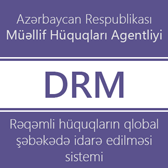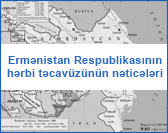Present situation, prospects and problems
Present situation, prospects and problems
Azerbaijan has a rich and ancient culture, and is famed for its scientists, scholars, writers and composers. Today, it is determined to keep its intellectual traditions alive, and to support and stimulate creative achievement. This is why the young state is so concerned with the problems of intellectual property, which have received the careful, far-sighted attention of its leaders. "Every person shall have intellectual property rights. Copyright shall be protected by law", says Article 30 of the Constitution, emphasizing the importance of those rights.
National copyright itself has three major components: a legislative and legal basis, an authority with power to enforce the state’s policy, and a system of measures to enforce protection and restore violated rights.
The growing importance of copyright and intellectual property, new developments in national and international law, problems resulting from technical progress – all of this obliges states to pay special attention to their legislative, regulatory, coordinating and supervisory functions in this area.
If politics is the art of the possible, then rights are the science of the necessary. State policy in the field of intellectual property must be conservative, yet open to improvement - mobile and stable at the same time. A copyright system cannot be conjured out of thin air, but it can be inherited, preserved and enriched by drawing on other traditions and other countries’ experience.
The Copyright and Related Rights Act determines the main thrust of state policy in this area, and provides for:
• action to encourage and stimulate scientific, literary and artistic creativity, and increase the nation’s cultural wealth;
• creation of a legislative basis for definition, enforcement and protection of copyright, drawing on the experience of the countries most advanced in this field;
• organization of the state authorities responsible for copyright and related rights;
• protection of the copyright of national rights-holders in other countries, through the development of international relations.
Mickiewicz once said: “To make a country live, you must make rights live too”. It is the state which ensures that the law does its job of enforcing rights effectively.
It is the state which provides a sound basis in law for solving all the problems raised by the creation and use of scholarly, literary and artistic works (copyright), and by performances, phonograms and broadcasts (related rights). Our taking of all these issues together reflects the fact that related rights derive from copyright, and also the desirability of regulating them in one text.
Azerbaijan traditionally makes a distinction between protection of rights (recognition of rights and the legal system applying to them) and defense of rights (action when they are violated or disputed). The new copyright law covers a wide range of enforcement measures, taking in the civil, criminal and administrative liability of violators. Protection of these rights is a state prerogative, and the state can use its full coercive machinery to enforce them.
International co-operation is another state prerogative, and allows the state to enforce the rights of national authors abroad, and the rights of foreign authors on its own territory.
However, the state’s role today is not limited to drafting national laws on the protection and defense of intellectual property rights, and to international enforcement of those rights. A number of new functions have been added to these traditional ones.
The first is co-ordination of the various organizations which administer the copyright and related rights of their members collectively.
If the state refused to co-ordinate their activities, the law would be broken more often by organizations claiming to represent rights-holders and demanding payment from users of their works. The everyday work of organizations lawfully administering such rights would also be complicated. This coordinating role is actually provided for in the Copyright Act, and could be reinforced by introducing a licensing system for royalty collection agencies. This is the situation in most developed countries (France, Germany, Spain, etc.), where a license from the appropriate state body is required for the collective administration of property rights.
The state’s important regulatory function is connected with its statutory task of administering public property, and can involve a policy of using special taxes and levies to promote cultural development, again through a special authority. Under this policy, assets made over to the state can be used as an extra-budgetary source of additional funds for culture.
This system is a good one, since it discourages the use of unprotected works, and promotes the creation and use of protected ones. It also serves the interest of the state, individuals and legal entities in ensuring compliance with copyright and related rights, and in supporting organizations which collectively administer them. Finally, it allows third parties to make use of public property.
Another important state function is organizing the voluntary registration of works by the state body established for that purpose. Although works are legally protected as soon as they are produced, the law in many countries favours authors who take steps to protect their rights by registering them. The benefits of registration – starting with formal recognition of a right and a warning to third parties that unauthorized use is prohibited, and ending with higher compensation for registered rights-holders in the event of violation – have a very important bearing on effective copyright protection. Of course, registered works must also be listed, catalogued and entered on electronic data bases, so that rights can be effectively administered at home, and information exchanged with other countries.
The state’s role in enforcing rights must also be mentioned. Although the protection of copyright and related rights is essentially based on personal rights (i.e. the rights-holder proceeds at his own discretion), state intervention in this area often contributes significantly to enforcement. The issue here is undoubtedly a reasonable combination of private and public action, and special attention should be paid to administrative measures and sanctions, which have the advantage of being quick and easy to use – particularly when there is a serious danger of piracy. Since enforcement is probably the most important aspect of copyright law (for holders of copyright and related rights, a system can seem perfect and still prove flawed, if it does not allow them to enforce their rights satisfactorily), the state’s role in enforcement is subject to special requirements. Special programmers, covering anti-piracy measures, classification of offences, coordinated action by the relevant ministries and agencies under the aegis of the state authority, supervision of the market, and publication of the results of court proceedings, play a major role here.
The legal protection of the nation’s folklore is another important state function. The study of folklore has rightly been called "archaeology of the human spirit", and this part of the heritage embodies a nation’s cultural identity, and also has a universal human value which makes it a part of world culture. Although folklore lies outside copyright, it can be protected as a form of “public property”. Action taken by WIPO and UNESCO in the last few years also suggests that international agreements and national laws to protect folklore per se may well be forthcoming in the near future.
The techniques and instruments used to enforce state policy on copyright and related rights in practice are obviously important. The State Copyright Agency is the main body responsible in Azerbaijan. The following section is taken from one of its documents, and shows how the national copyright system operates, and how aims, functions, structures and specific measures connect and combine to implement state policy in this area.
K.Imanov, 2005



















